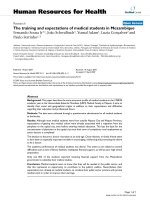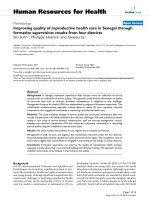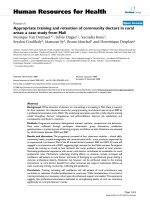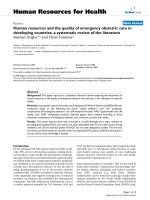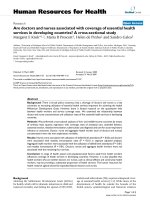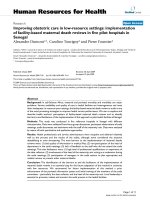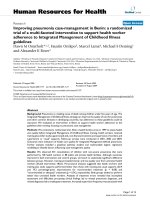báo cáo sinh học:" Improving retention and performance in civil society in Uganda" pot
Bạn đang xem bản rút gọn của tài liệu. Xem và tải ngay bản đầy đủ của tài liệu tại đây (205.85 KB, 4 trang )
BioMed Central
Page 1 of 4
(page number not for citation purposes)
Human Resources for Health
Open Access
Commentary
Improving retention and performance in civil society in Uganda
Mary L O'Neil*
1
and Michael Paydos
2
Address:
1
Center for Leadership and Management, Management Sciences for Health, Cambridge, MA, USA and
2
Leadership, Management, and
Sustainability Program, Management Sciences for Health, Cambridge, MA, USA
Email: Mary L O'Neil* - ; Michael Paydos -
* Corresponding author
Abstract
This article is the second article in the Human Resources for Health journal's first quarterly feature.
The series of seven articles has been contributed by Management Sciences for Health (MSH) under
the theme of leadership and management in public health and will be published article-by-article
over the next few weeks. The journal invited Dr Manuel M. Dayrit, Director of the WHO
Department of Human Resources for Health and former Minister of Health for the Philippines to
launch the feature with an opening editorial to be found in the journal's blog.
This article – number two in the series – describes the experience of the Family Life Education
Programme (FLEP), a reproductive health program that provides community-based health services
through 40 clinics in five districts of Uganda, in improving retention and performance by using the
Management Sciences for Health (MSH) Human Resource Management Rapid Assessment Tool.
A few years ago, the FLEP of Busoga Diocese began to see an increase in staff turnover and a
decrease in overall organizational performance. The workplace climate was poor and people
stopped coming for services even though there were few other choices in the area. An external
assessment found the quality of the health care services provided was deficient.
An action plan to improve their human resource management (HRM) system was developed and
implemented. To assess the strengths and weaknesses of their system and to develop an action
plan, they used the Rapid Assessment Tool. The tool guides users through a process of prioritizing
and action planning after the assessment is done.
By implementing the various recommended changes, FLEP established an improved, responsive
HRM system. Increased employee satisfaction led to less staff turnover, better performance, and
increased utilization of health services. These benefits were achieved by cost-effective measures
focused on professionalizing the organization's approach to HRM.
Introduction
The Family Life Education Program (FLEP) of the Busoga
Diocese of Uganda, a multi-service reproductive health
agency that operates 40 rural clinics in five districts of
Uganda was supported in part by the DISH II project, a
project funded by the US Agency for International Devel-
opment (USAID) [1]. FLEP provides community-based
health services, including family planning, immuniza-
tion, maternal health, nutrition, and HIV & AIDS coun-
seling. At the end of the DISH II project, the services of
Published: 20 June 2008
Human Resources for Health 2008, 6:11 doi:10.1186/1478-4491-6-11
Received: 24 April 2008
Accepted: 20 June 2008
This article is available from: />© 2008 O'Neil and Paydos; licensee BioMed Central Ltd.
This is an Open Access article distributed under the terms of the Creative Commons Attribution License ( />),
which permits unrestricted use, distribution, and reproduction in any medium, provided the original work is properly cited.
Human Resources for Health 2008, 6:11 />Page 2 of 4
(page number not for citation purposes)
FLEP were continued by the Planning and Development
Department of Busoga Diocese.
When the program began to see an increase in staff turno-
ver and a decrease in overall organizational performance,
MSH was asked to help. The workplace climate was poor
and people had stopped coming for services. FLEP's lead-
ers decided it was time to examine their HRM system and
practices.
In August 2001, the senior managers at FLEP used MSH's
HRM Assessment Tool to examine the functioning of their
HRM system. This tool provides users with a rapid way to
identify the strengths and weaknesses of their HRM sys-
tem and develop an action plan for improvement. The
exercise, including the action plan, can be completed in
one day.
The instrument consists of a matrix of 23 HRM compo-
nents that fall into six broad areas of HRM:
1. HRM capacity
▪ HRM budget and staff
2. HR planning
▪ organizational mission and goals
▪ HR planning
3. Personnel policy and practice
▪ job classification system
▪ compensation and benefits system
▪ recruitment, hiring, transfer, and promotion
▪ orientation program
▪ policy manual
▪ discipline, termination, and grievance procedures
▪ relationships with unions
▪ labor law compliance
4. HRM Data
▪ employee data
▪ computerization of data
▪ personnel files
5. Performance Management
▪ job descriptions
▪ staff supervision
▪ work planning and performance review
6. Training
▪ staff training
▪ management and leadership development
▪ links to external pre-service training
The tool also describes four stages of development for
each component and provides blank spaces for users to
write a brief statement, or indicator, to show how the
organization fits into a particular stage of development.
Discussion
After the assessment, FLEP's management committee
reviewed the results and determined the priorities for
action. Their priorities were to:
▪ revise and update the personnel policy manual;
▪ complete personnel files and make them open to staff;
▪ update job descriptions;
▪ develop a new process for performance appraisal and
strengthen supervision;
▪ improve communications among the 40 far-flung clin-
ics.
Longer-range priorities were likewise planned for staff
training, strengthening of management and leadership at
all levels of the organization, and annual reviews of salary
policy. A survey measuring employee satisfaction was car-
ried out in September 2001 to identify other areas for
intervention. In addition, FLEP managers worked with
MSH to develop a monitoring and evaluation plan using
indicators that would track HR management and perform-
ance components.
MSH staff and the FLEP Human Resource Administrator
met with two representatives of the FLEP board of direc-
tors and briefed them on the HRM assessment, priorities
identified, proposed actions, and indicators to measure
performance improvement. The board members agreed
that the need to improve FLEP's HRM was urgent, and
they fully supported the proposed HR plan and new man-
agement approach.
The Achievements of the Program
With MSH technical assistance, FLEP established a
responsive HRM system. FLEP revised and updated its per-
Human Resources for Health 2008, 6:11 />Page 3 of 4
(page number not for citation purposes)
sonnel policy and procedures, and produced and distrib-
uted a new personnel manual to management and
supervisory staff at the clinics. Personnel files were com-
pleted and job descriptions were updated. A senior man-
agement team was installed at headquarters. Operations
were streamlined by reducing the number of zonal coor-
dinators from eight to four and Volunteer Health Worker
supervisors from seventeen to eight. Poor-performing staff
were dismissed and the remaining staff were given fixed
contracts until the end of the project, which gave them an
increased sense of security. A performance appraisal proc-
ess was instituted, and supervisors were trained in basic
supervision skills and the use of appraisal forms and a
supervisory checklist.
These measures did not require additional funding or
resources. Rather they reflected the commitment of the
leadership team to support health staff by increasing
equity, accountability, and opportunity in the workplace.
When the staff satisfaction and organizational survey was
conducted again, in June 2002, it revealed significant
improvements in ten (83%) of the twelve indicators,
including employee satisfaction and commitment (see
Figure 1). Two indicators of staff satisfaction did not
increase: staff benefits and accuracy of job description,
items that required more resources to address. In just one
year's time, the functioning of management systems and
delivery of health services improved significantly (see Fig-
ure 2). While FLEP's transformation may not be typical of
that of all nongovernmental organizations, MSH's experi-
ence offers important insights – not only into the linkages
between strong internal leadership, strengthened manage-
ment systems, better work climate, and improved health
Improved employee satisfaction due to better human resource managementFigure 1
Improved employee satisfaction due to better human resource management.
Increased utilization of servicesFigure 2
Increased utilization of services.
Publish with Bio Med Central and every
scientist can read your work free of charge
"BioMed Central will be the most significant development for
disseminating the results of biomedical research in our lifetime."
Sir Paul Nurse, Cancer Research UK
Your research papers will be:
available free of charge to the entire biomedical community
peer reviewed and published immediately upon acceptance
cited in PubMed and archived on PubMed Central
yours — you keep the copyright
Submit your manuscript here:
/>BioMedcentral
Human Resources for Health 2008, 6:11 />Page 4 of 4
(page number not for citation purposes)
services, but also in the ability of an organization to per-
severe through difficult times.
Conclusion
The factors that contributed to this program's success
were:
▪ a visionary leader who involved teams at all levels;
▪ establishing priorities based on assessment and root
cause analysis;
▪ creating a climate of support for managers who were for-
merly isolated;
▪ establishing standards of performance and rewarding
people for meeting or exceeding them;
▪ linking change to HRM systems.
The individuals leading this and similar transformations
are not extraordinary. They are often doctors who have
spent their careers working to improve health in their
countries. What makes them effective in getting results is
their commitment to addressing the human resource cri-
sis and move from vision to action. In the process, they
work to enable others to face challenges and achieve
results, understanding that implementing change in
human resources requires new ways of working.
Competing interests
The authors declare that they have no competing interests.
References
1. Family Life Education Programme [ogadio
cese.org/index.html]

